Ecole Nationale Supérieure Agronomique de Montpellier ... - CIAM
Ecole Nationale Supérieure Agronomique de Montpellier ... - CIAM
Ecole Nationale Supérieure Agronomique de Montpellier ... - CIAM
You also want an ePaper? Increase the reach of your titles
YUMPU automatically turns print PDFs into web optimized ePapers that Google loves.
original process is performed. The observed segment length distribution<br />
remains generally outsi<strong>de</strong> the interval confi<strong>de</strong>nce band, leading<br />
to a rejection of the boolean assumption. Similarly, the thick line<br />
representing the p-value p(x) remains below 5%.<br />
Figure 1(d) presents the result of the test after dilation. The observed<br />
segment length distribution is presented in thin plain line with<br />
its 95% individual confi<strong>de</strong>nce band in broken line. The observed curve<br />
lies insi<strong>de</strong> its individual confi<strong>de</strong>nce band un<strong>de</strong>r the boolean assumption.<br />
The thick broken line presents the changes of the p-value p(x).<br />
This last function is never below 0.42, corresponding to no rejection<br />
of the boolean assumption.<br />
In this case, not taking into account the non-convexity may lead<br />
to falsely reject the boolean assumption.<br />
3.2 Strauss mo<strong>de</strong>l of typical points<br />
The Strauss mo<strong>de</strong>l used was <strong>de</strong>fined with the following parameters.<br />
Point process intensity was λ = 24.3, inhibition parameter c = 0.5<br />
and inhibition distance r = 0.44. Same grains as above are attached<br />
to each point. Observation window was a 5×5 square. For testing, the<br />
bound was chosen equal to b = 0.244, distance between consecutive<br />
horizontal transects was equal to b.<br />
Figure 2(a) presents a realization of the process, figure 2(b) the<br />
result of the dilation of this realization observed on the intersection<br />
with the transects.<br />
Figure 2(c) presents the result of the test when no dilation is performed.<br />
The observed segment length distribution lies outsi<strong>de</strong> the<br />
individual confi<strong>de</strong>nce band build un<strong>de</strong>r H0, its p-value function being<br />
always near 0, so that the boolean assumption is rejected. However,<br />
rejection is not so much due to a lack of short length segments as<br />
expected from the Strauss process, but to an excess due to the grain<br />
non-convexity. Not taking into account the grain shape but just looking<br />
at such curves may then lead to misinterpretations, as for example<br />
concluding the typical point process is not Poisson but an aggregative<br />
process instead of a regular one.<br />
Figure 2(d) presents the result of the test after dilation of the original<br />
process. The observed segment length lies outsi<strong>de</strong> the confi<strong>de</strong>nce<br />
bound for short lengths, leading to rejection of the boolean assumption,<br />
but the curve lies near the limits of the confi<strong>de</strong>nce bound.<br />
From the test procedure itself, in the case of a regular process,



